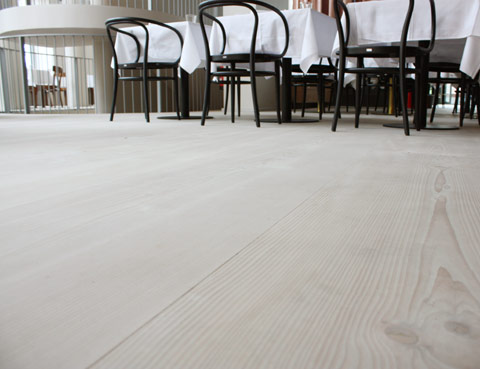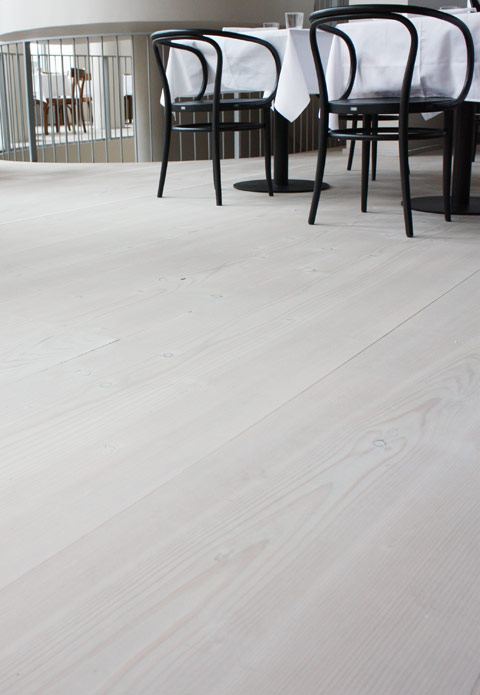Jels is a small, sleepy village not far from the German-Danish border and one wouldn't think that one of the leading international manufacturers of high-grade wooden floors is to be found there. However, a visit to Dinesen, which was founded in 1898 by Hans Peter Dinesen and is currently run in the fourth generation by Heidi and Thomas Dinesen, makes a trip to this Danish backwater a very special experience.
Hans Peter Dinesen founded a small saw mill at the end of the 19th century after finding no suitable wood for his building work. The trigger for today's success came in 1965 with an inquiry from an architect who was looking for extremely long floor planks for the restoration of Sønderborg Castle. Dinesen accepted the challenge and decided on Douglas fir, from which planks in the almost unbelievable length of up to 15 metres and a width of up to 45 cm are still made today. The wood comes from various European forests and is carefully selected. On arrival in Jels, it is frequently dried in heat chambers for quite a time to ensure there is absolutely no more moisture in the wood. Subsequently, the planks are cut in an elaborate procedure and checked by hand. Thus, every floor is a special project and the result of a long process.
Architects have been so impressed by the quality, finish and longevity of the floors that, for many decades, Dinesen primarily produced floors for castles, manor houses and churches. In recent years, however, wooden floors have become increasingly popular in the modern interior-design sphere, which opened up undreamt of new markets for the company. Today, Dinesen floors are to be found in modern dwellings, showrooms, (e.g., all new Bulthaup showrooms have Dinesen floors), hotels, restaurants, museums and galleries. Contrary to stubborn prejudice, planks can be laid in conjunction with under-floor heating and caring for them is no more difficult than any other kind of floor.
A milestone in 2008 was the opening of the new Saatchi Gallery in London, for which Dinesen supplied 5,000 square metres of Douglas fir as a Founding Patron. Charles Saatchi is said to have been so enthusiastic about the aesthetic impact of the floor as a design element that he positioned fewer works of art in the rooms so that the floor comes more into its own. It actually doesn't matter whether this is strictly true or not, what counts is the phenomenal spatial impact.
The situation at Museum Brandhorst, which was designed by architects Sauerbruch Hutton in Munich and opened at the end of May, is similar. The floor is made of Dinesen oak plans and forms an important design element in the overall concept. ‘Table', the restaurant in Frankfurt's Schirn art gallery, which was opened this April, also makes use of extra-large planks thus making the floor a central element in this case, too.
In other words, there is no way today around Dinesen for anyone considering a wooden floor for a classic or modern ambience.




 Saatchi Gallery, London
Saatchi Gallery, London
 Saatchi Gallery, London
Saatchi Gallery, London
 ‘Table’, the restaurant in Frankfurt’s Schirn art gallery | Photo © Dimitrios Tsatsas, Stylepark
‘Table’, the restaurant in Frankfurt’s Schirn art gallery | Photo © Dimitrios Tsatsas, Stylepark
 ‘Table’, the restaurant in Frankfurt’s Schirn art gallery | Photo © Dimitrios Tsatsas, Stylepark
‘Table’, the restaurant in Frankfurt’s Schirn art gallery | Photo © Dimitrios Tsatsas, Stylepark




 Saatchi Gallery, London
Saatchi Gallery, London
 Saatchi Gallery, London
Saatchi Gallery, London
 Museum Brandhorst, Munich; © Noshe
Museum Brandhorst, Munich; © Noshe
 ‘Table’, the restaurant in Frankfurt’s Schirn art gallery | Photo © Dimitrios Tsatsas, Stylepark
‘Table’, the restaurant in Frankfurt’s Schirn art gallery | Photo © Dimitrios Tsatsas, Stylepark
